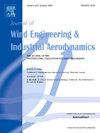Turbulent characteristics in the atmospheric boundary layer under neutral and unstable thermal stratifications based on LES
IF 4.9
2区 工程技术
Q1 ENGINEERING, CIVIL
Journal of Wind Engineering and Industrial Aerodynamics
Pub Date : 2025-05-14
DOI:10.1016/j.jweia.2025.106126
引用次数: 0
Abstract
In the atmospheric boundary layer (ABL), thermal stratification plays a crucial role in influencing turbulent characteristics. However, comprehensive analyses of turbulent characteristics under varying thermal conditions, particularly concerning higher-order statistics, remain limited. Therefore, in this study, one neutral and seven unstable turbulent boundary layers were reproduced by large-eddy simulations. The results show that under unstable conditions, buoyancy effects primarily influence the streamwise velocity in the near-wall region, vertical velocity in regions slightly away from the wall, and the temperature throughout the entire boundary layer height. Turbulence intensity in the vertical direction is significantly affected by the buoyancy effects, while the turbulence intensities in the streamwise and lateral directions are primarily dominated by shear production. As the bulk Richardson number increases, boundary layer height and maximum turbulent kinetic energy decrease. Furthermore, thermal stratification can influence higher-order turbulence statistics near the surface under strongly unstable conditions, but the overall statistical patterns tend to exhibit universal behavior. Within the boundary layer height, the skewness and kurtosis velocities in the unstable cases exhibit generally consistent trends with those in the neutral case, within the range of bulk Richardson numbers from −0.3 to 0.
基于LES的中性和不稳定热分层下大气边界层湍流特征
在大气边界层中,热分层对湍流特性的影响至关重要。然而,对不同热条件下湍流特性的综合分析,特别是关于高阶统计量的分析仍然有限。因此,本研究通过大涡模拟再现了1个中性湍流边界层和7个不稳定湍流边界层。结果表明,在不稳定条件下,浮力效应主要影响近壁面区域的流向速度、稍远离壁面区域的垂直速度以及整个边界层高度的温度。垂直方向的湍流强度主要受浮力效应的影响,而顺流方向和横向方向的湍流强度主要受切变产生的影响。随着体理查德森数的增加,边界层高度和最大湍流动能减小。此外,在强不稳定条件下,热分层可以影响地表附近的高阶湍流统计,但总体统计模式倾向于表现出普遍的行为。在边界层高度范围内,不稳定情况下的偏度和峰度速度与中性情况下的偏度和峰度速度在体积理查德森数从−0.3到0的范围内呈现出基本一致的趋势。
本文章由计算机程序翻译,如有差异,请以英文原文为准。
求助全文
约1分钟内获得全文
求助全文
来源期刊
CiteScore
8.90
自引率
22.90%
发文量
306
审稿时长
4.4 months
期刊介绍:
The objective of the journal is to provide a means for the publication and interchange of information, on an international basis, on all those aspects of wind engineering that are included in the activities of the International Association for Wind Engineering http://www.iawe.org/. These are: social and economic impact of wind effects; wind characteristics and structure, local wind environments, wind loads and structural response, diffusion, pollutant dispersion and matter transport, wind effects on building heat loss and ventilation, wind effects on transport systems, aerodynamic aspects of wind energy generation, and codification of wind effects.
Papers on these subjects describing full-scale measurements, wind-tunnel simulation studies, computational or theoretical methods are published, as well as papers dealing with the development of techniques and apparatus for wind engineering experiments.

 求助内容:
求助内容: 应助结果提醒方式:
应助结果提醒方式:


